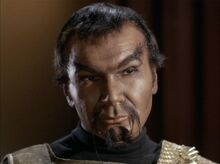No edit summary Tag: Visual edit |
No edit summary Tag: Visual edit |
||
| (14 intermediate revisions by 3 users not shown) | |||
| Line 1: | Line 1: | ||
| + | "''A Klingon's honor means more to him than his life!''" |
||
| ⚫ | |||
| + | |||
| − | The '''Klingons '''(Second Human Empire: ?) are a humanoid warrior species that originated from the planet Qo'noS (pronounced ''Kronos''), an M-class planet. One of the major powers of the galaxy, the Klingons were a proud, tradition-bound people who valued honor and combat. The aggressive Klingon culture had made them an interstellar military power to be respected and feared. |
||
| + | – '''[[Kurn (Klingon)|Kurn]]'''[[File:Klaa, Korrd and Vixis.jpg|thumb|220x220px|Klaa, Jorrid and Vixis]] |
||
| ⚫ | |||
| ⚫ | |||
| ⚫ | |||
| + | The '''Klingons '''(Second Human Empire: '''Hamo Tuiy'kio Ciuyi'nuggh''') are a humanoid warrior species that originated from the planet [[Qo'noS]] (pronounced ''Kronos''), an M-class planet. One of the major powers of the galaxy, the Klingons were a proud, tradition-bound people who valued honor and combat. The aggressive Klingon culture had made them an interstellar military power to be respected and feared. The most distinctive feature of Klingon anatomy (except in those individuals afflicted with the Augment virus) was a sagittal crest, beginning on the forehead and often continuing over the skull. The cranium was encased in an exoskeleton, which possessed a feature known as the tricipital lobe. Internally, Klingon anatomy was markedly different from that of Humans. There was a great deal more multiple redundancy in their organs, a principle they called ''brak'lul''. This allowed Klingons to survive severe injuries in battle. They had twenty-three ribs, two livers, an eight-chambered heart, three lungs, and even redundant neural function as well as multiple stomachs. Some geneticists believed that the extra organs, notably the third lung, evolved to give Klingons greater stamina on the battlefield. Klingons had relatively little knowledge of their own biology and their medicine was very poorly developed. This was largely due to their warrior traditions – a Klingon who was wounded was expected to be left to either survive through his own strength, die, or undergo the ''hegh'bat'', a form of ritual suicide. The Klingons joined mostly the [[Axis of Empires]], though some of them joined the [[Alliance of Nations]] (most notably [[Worf]] and [[Alexander Rozhenko]]) and the Coalition ([[Duras, son of Ja'rod]], a founder of their rebels).[[Category:Races]][[Category:Factions]] |
||
| ⚫ | |||
| ⚫ | |||
| + | [[Category:Federalist]] |
||
[[Category:Axis]] |
[[Category:Axis]] |
||
| + | [[Category:Imperialist]] |
||
| + | [[Category:Nationalist]] |
||
| ⚫ | |||
| ⚫ | |||
| + | [[Category:Delta Sword Rebels]] |
||
Revision as of 23:23, 7 June 2018
"A Klingon's honor means more to him than his life!"
– Kurn

Klaa, Jorrid and Vixis

Kor, a very well known Klingon
The Klingons (Second Human Empire: Hamo Tuiy'kio Ciuyi'nuggh) are a humanoid warrior species that originated from the planet Qo'noS (pronounced Kronos), an M-class planet. One of the major powers of the galaxy, the Klingons were a proud, tradition-bound people who valued honor and combat. The aggressive Klingon culture had made them an interstellar military power to be respected and feared. The most distinctive feature of Klingon anatomy (except in those individuals afflicted with the Augment virus) was a sagittal crest, beginning on the forehead and often continuing over the skull. The cranium was encased in an exoskeleton, which possessed a feature known as the tricipital lobe. Internally, Klingon anatomy was markedly different from that of Humans. There was a great deal more multiple redundancy in their organs, a principle they called brak'lul. This allowed Klingons to survive severe injuries in battle. They had twenty-three ribs, two livers, an eight-chambered heart, three lungs, and even redundant neural function as well as multiple stomachs. Some geneticists believed that the extra organs, notably the third lung, evolved to give Klingons greater stamina on the battlefield. Klingons had relatively little knowledge of their own biology and their medicine was very poorly developed. This was largely due to their warrior traditions – a Klingon who was wounded was expected to be left to either survive through his own strength, die, or undergo the hegh'bat, a form of ritual suicide. The Klingons joined mostly the Axis of Empires, though some of them joined the Alliance of Nations (most notably Worf and Alexander Rozhenko) and the Coalition (Duras, son of Ja'rod, a founder of their rebels).
